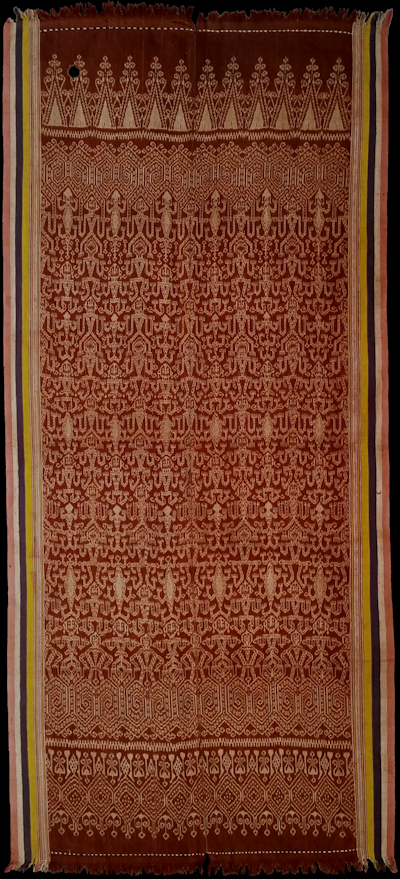| |
 
 | | | |
153 Borneo, Kalimantan
Pua (blanket)  
| | Locale: | Iban people, most likely from Badau or other Iban areas along that side of the Kalimantan border, down as far as opposite Engkili in Sarawak. | | Period: | 19th c. | | Yarn: | Cotton, hand-spun, extremely fine | | Technique: | Warp ikat | | Panels: | 2 | | Size: | 81 x 181 cm (2' 7" x 5' 11") LW: 2.23 | | Weight: | 390 g (13.8 oz), 266 g/m2 (0.87 oz/ft2) | | Design: | Multiple rows of engkeramba, larger and smaller, of continually varying design that appear to give birth to one another, interspersed with headless figures representing human prey, and, on the top row, with crocodiles. Crocodiles served as the guardian spirit of many Iban males, and as bringers of fertility. The drawing (three folds per panel) is of remarkable ingenuity, and the densely packed end panels show great virtuosity. The finest design elements are just two yarns wide, hence made with binding on bundles merely twelve yarns wide. | | Comment: | The cloth was dyed, not in the mengkudu used by most Iban, but in the chocolaty brown engkaramba more common in Kalimantan. As the cloth is so fine, at first sight we thought that the yarn must be machine-made, but microscopic inspection reveals very fine hand-spun - as also used in the Hose example, below. Note the extremely low specific weight, only about two-thirds of the average Iban pua. | | Background: | Chapters on Borneo and Kalimantan. | | Sources: | Very similar to pua in Gavin, The Women's Warpath, Plate 53, but with less elaborate borders and the addition of crocodiles. Similar to ca. 1900 Saribas pua in Amann Collection, Khan Majlis, Textiles of Borneo, Fig. 21; and to two in Ong, Pua, Iban Weavings of Sarawak, Plates 5 and 16, but more intricate. Very similar to pua in Haddon and Start, Iban or Sea Dayak Fabrics and their Patterns, Plate XXXIV, pua 35.923, described on pp. 111, 112, but smaller and with more intricate detailing - except in the borders, where the Hose example stands out with ikated. End panels are also similar, one having a row of triangles with elaborate borders, 12 of them in our example, 8 in Hose's, the other having finely wrought lozenges, again 12 versus 8. The numbers are quite remarkable, as our example is a quarter smaller, so that, to fit in 50% more detail our weaver needed the skills for extremely fine drawing. The fact that the two panels were not sewn together till the very end, thus Michael Heppell (pers. comm., 2017), indicates that the weaver was of childbearing age. Only after menopause will weavers tie the panels together over the full length of the warp. Given the slight imperfections in this ambitious weaving, this may well be one of the first powerful cloths she created on her path to recognition as a master weaver. | | |

©Peter ten Hoopen, 2025
All rights reserved.
|
|


